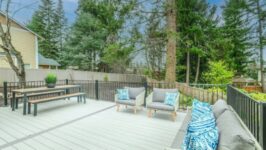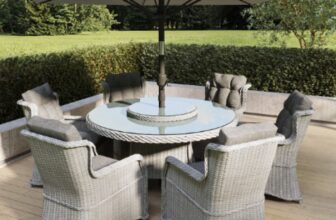
7 Reasons to Choose Composite Decking
Composite decking is made using a blend of wood (which may include sawdust, wood chips, or wood fiber chunks) and plastic, giving it more strength and density than wood. Investing in composite decking comes with multiple rewards. Outlined below are seven reasons to choose composite decking.
Eco-friendliness
Composite decking is suitable for every homeowner seeking to embrace eco-friendly home improvements. It’s made from wood waste, such as sawdust, that would have otherwise ended up in landfills, which reduces the amount of waste going to dumpsites and virgin wood demand. This helps:
- Minimize habitat degradation and deforestation
- Preserve forests
- Cut dependence on timber plantations and logging
Additionally, composite decking contains a range of recycled plastics, significantly reducing the amount of plastics in landfills. Composite decking needs considerably less care than conventional wood decking. Its maintenance doesn’t involve regular sealing treatments, oiling, or painting. Composite decking doesn’t require chemical treatments to avoid termite and water/ moisture damage, making it great for the environment.
Compared to traditional wood decking, composite decking is durable and lasts longer, reducing the possibility of frequent replacements and repairs. You order premium-quality composite decking from Harbor Exports or other reliable suppliers.
Low maintenance
Although highly durable composite decking requires care to preserve its appearance and longevity. Unlike wood decking, which calls for annual staining and sanding to avoid rot because of constant exposure to elements, you can clean your composite decking periodically using warm water and soap. Composite decking is meant to withstand staining, fading, and element exposure-related damage. Its low-maintenance nature gives you more time to enjoy your space rather than spending much time caring for it.
Additionally, wood decking maintenance is less labor-intensive than composite decking.
Composite decking provides built-in protection because its weather-resistant exterior shell is made from post-consumer sawdust and reclaimed plastic film. The blend of man-made and organic materials enables composite decking to resist elements without warping or fading. Its fade resistance ensures color consistency over time. Additionally, composite decking doesn’t need sealing to lock out moisture.
Composite decking is weather-resistant
Composite decking is resistant to any extreme weather. Its manufacturing process makes it resistant to UV rays, meaning its colors won’t fade or get bleached by sunlight. While premium-quality composite decking is made to provide natural wood texture, it doesn’t soak up water, meaning it isn’t susceptible to freezing. Unlike wood decking, composite decking doesn’t need sealing to prevent cracking and breaking in winter. It’s also resistant to moisture, preventing the possibility of rot.
Durability
Composite decking can last about 25 years and more, compared to wood decking, requiring just a fraction of the wood deck’s routine maintenance. The materials used to make this kind of decking significantly contribute to its longevity and strength. The plastics used to make composite boards safeguard them from multiple significant problems associated with wood decking, such as:
- Warping
- Rot
- Splitting
- Splinters
The wood fibers in composite decking are plastic-coated, which helps protect them from these concerns while ensuring insects don’t attack them. The stain-resistant and durable materials used to make composite decks can resist natural wear and tear and harsh weather, boosting longevity. The fact that composite decking can withstand moisture and water means it can’t be damaged when exposed to these elements, boosting its durability.
Slip resistance
Slip resistance is a vital feature in composite decking, making it safe for its users. Unlike wood decks, which need routine maintenance and treatment to remain slip-resistant, composite decks’ anti-slip properties are natural/ built-in. Composite decking is resistant to mold, algae, and mildew and absorbs little to no water, which can be quite advantageous in wet conditions and over time. Even when wet, this form of decking has a low slip potential.
Cost efficiency
While initial composite decking costs may be high, it becomes cost-effective over time once you factor in its durability and maintenance. Unlike traditional wood decking that requires regular maintenance, repairs, and staining, composite decks only need to be cleaned with soap and water to maintain their appearance and longevity.
Since composite decking lasts longer than wood decking, you won’t have to replace it as often, saving the costs associated with new installations. Composite decks don’t require sealing or treatments to protect them from insects, boosting their cost efficiency.
Add to your home’s value
Adding premium-quality composite decking can help elevate your home’s value by increasing usable living space. Composite decking offers more benefits than its wooden counterpart, offering more value. These rewards include:
- Durability
- Low maintenance
- Ideal for all weather conditions and more
Endnote
Adding composite decking to your property can be rewarding. Familiarizing yourself with the reasons to choose composite decking can help determine whether it’s worth your money.





















































































